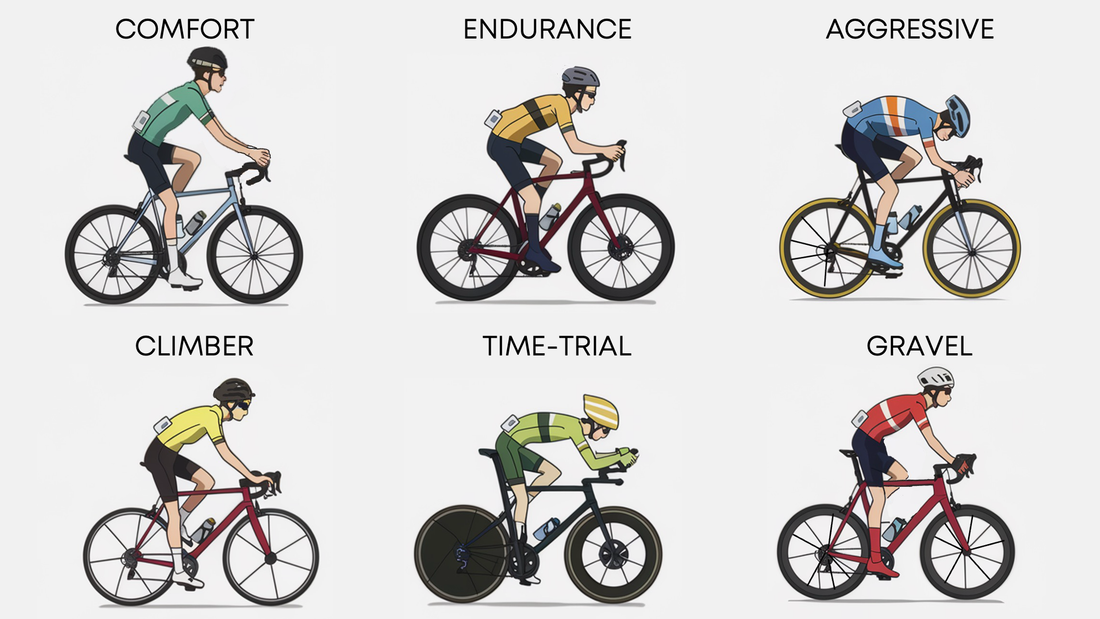
Different Styles of Road-Cycling
Share
Not all road-cycling is the same. Not all road cyclists are the same.
The sport is not just for elite athletes who can sit in aerodynamic positions and output extreme power for hours on end. Road-cycling can be enjoyed by a wide range of people looking to spend time outside (or inside, now with e-cycling) and improve their health, including physical, mental, and social well-being.
By understanding the different cycling styles, you can get the most out of cycling, buy appropriate equipment, minimise the risk of injury, and create achievable goals for yourself. Efficient cycling style utilises body posture, incorporating different aspects of performance and comfort to meet your needs and achieve targets.
Cycling as a sport is always developing, and although we have tried to give an honest and fair representation of it, we have excluded e-cycling as a cycling style. However, most of the styles explored can be implemented by e-cyclists with transferable knowledge. We plan to create a full guide to e-cycling in the future, incorporating aspects outside the range of this guide.
Comfort
Comfort cycling prioritises a relaxed position, suitable for casual riders or those new to road-cycling. The focus is on minimising strain on the back, shoulders, and wrists, making it ideal for leisurely rides.
- For people with lower flexibility and core strength.
- Upright posture.
- Higher handlebar position.
- Shorter reach to handlebars.
Practical Tip: Use a bike with a more relaxed geometry, such as a touring or endurance frame, to enhance comfort during long rides.
Endurance
Endurance cycling balances comfort and performance, allowing for long-distance rides without compromising speed. It’s ideal for sportive events and recreational riders who cover significant distances.
- For people with higher stamina and ambition.
- Varied posture for reduced fatigue.
- Compact frame geometry.
- Saddle and handlebar positions optimised for sustained effort.
Practical Tip: Ensure a slightly shorter reach and a moderate handlebar drop to maintain comfort over long rides. Variation in posture is often required during extended rides, and an endurance setup allows switching between cycling styles or hand positions.
Aggressive
Aggressive cycling focuses on speed and aerodynamics, making it ideal for competitive road cyclists and sprinters. The setup sacrifices some comfort for improved performance.
- For people with good flexibility and strength.
- Lower head, back, and body posture with more neck extension.
- Low handlebar position and longer reach to handlebars for an aerodynamic profile.
- Stiffer frame for efficient power transfer and stability when pedalling out of the saddle.
Practical Tip: This style is often seen among professional cyclists but should not be adopted immediately by beginners. Gradually adapt to a lower handlebar position to avoid discomfort or strain.
Climbing
Climbing-oriented cycling utilises a lightweight setup and efficient power transfer for tackling steep gradients. Riders often prioritise weight savings, good breathing techniques, and an optimised pedalling position.
- For people with strength, stamina, and a dedication to leg day.
- More upright position to open lungs and diaphragm, with slightly bent elbows.
- Compact cranksets for easier gearing and a slightly forward saddle for better leverage.
- Lightweight components and frames, with slightly higher handlebars.
Practical Tip: Use a lower gear ratio to maintain a steady cadence and conserve energy on long climbs. Staying seated, outputting consistent power, and using gears efficiently are key to success.
Time-Trial
Time-trial cycling is all about achieving maximum speed against the clock, often in a solo effort. This style requires an aerodynamic and forward-leaning position, paired with specialised equipment.
- For people with advanced flexibility who like to go fast.
- Aggressive, very low, and forward position to minimise wind resistance.
- Aerodynamic frame and components, including aero bars.
- Saddle pushed forward to optimise power output and low handlebars.
Practical Tip: Consider professional fitting for time-trial setups, as the aggressive position demands precise adjustments to prevent discomfort and maximise efficiency.
Gravel
Gravel cycling is a versatile and adventurous style of road-cycling that blends elements of road and off-road riding. It’s ideal for riders who want to explore unpaved roads, trails, and mixed terrains while maintaining speed and endurance. This style emphasises durability, control, and comfort over pure aerodynamics or speed.
- For people who want to go far but not always on roads.
- Upright and balanced posture for control and comfort on uneven terrain.
- Wider tyres with tread patterns for better grip and stability on gravel and dirt roads.
- Flared handlebars for extra control and leverage, especially during descents.
- More forgiving frame geometry, often with a higher stack and shorter reach for endurance over long rides, along with reinforced features.
Practical Tip: Gravel cycling is perfect for riders who want to escape busy roads but do not want the risks or physical demands of mountain biking. Invest in tubeless tyres to reduce the risk of punctures, and start on mild gravel paths, gradually increasing your confidence on loose or technical terrain.
Continue reading with Measuring Your Body for Road-Cycling
